15-3: Organizational Change
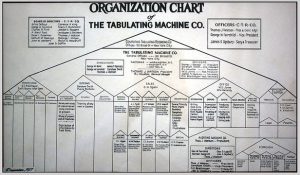 Organizational change is both necessary and inevitable in contemporary business environments. You’ve probably experienced organizational change yourself – maybe your favorite restaurant changed its menu, your school implemented new technology systems, or a company you worked for got acquired by another company.
Organizational change is both necessary and inevitable in contemporary business environments. You’ve probably experienced organizational change yourself – maybe your favorite restaurant changed its menu, your school implemented new technology systems, or a company you worked for got acquired by another company.
Multiple forces create pressure for adaptation. Downsizing involves asking fewer employees to do more things. It also almost always involves eliminating middle-level managers, increasing the span of control of those managers left, and increasing the autonomy of the subordinates who remain. This is a massive change in work organization, and virtually every modern organization has downsized or will do so in the near future.
Mergers, acquisitions, and alliances create needs for change as previously independent entities must integrate systems, cultures, and processes. Globalization and outsourcing require organizations to develop new capabilities for managing distributed operations and virtual relationships. Technology evolution continuously creates opportunities and pressures for change as new technologies enable different ways of organizing work while making existing approaches obsolete.
Barriers to Organizational Change
Barriers to organizational change operate at both individual and organizational levels, and understanding them helps explain why change is often so difficult.
Individual barriers include economic fears about job security, fear of unknown consequences, and concerns about altered social relationships that may result from changes. Have you ever resisted a change at work or school simply because you weren’t sure how it would affect you? That’s completely normal – uncertainty makes most people uncomfortable.
Organizational barriers include structural inertia that makes it difficult to change job descriptions, duties, and reporting relationships. Work group inertia often codifies existing practices in written procedures and agreements that resist change efforts. There might also be threats to existing power balances and memories of prior unsuccessful change efforts that make people skeptical.
Models of Organizational Change
Force field analysis suggests that organizational stability results from equilibrium between forces supporting change and forces maintaining the status quo. Planned change occurs when forces for change overcome forces against change. For planned change to occur with the least amount of tension and resistance, it’s often better to try reducing forces maintaining the status quo rather than trying to increase forces for change.
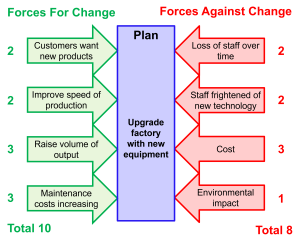
Lewin’s change model provides a three-stage framework that many organizations still use today. Unfreezing involves breaking down forces that maintain the status quo and creating motivation for change. Moving represents the phase where actual change occurs as reflected in altered attitudes, values, and behaviors. Refreezing involves establishing new equilibrium with changes in place and creating support systems that maintain changes over time.

The action research model combines theory building with research on real-world problems through cyclical processes where research should inform practice. This approach emphasizes the importance of understanding what’s happening before trying to change it.
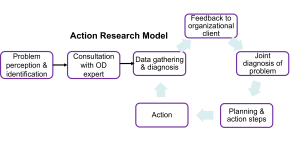
Organizational Development (OD)
Organizational Development represents planned, organization-wide efforts to increase effectiveness through behavioral science knowledge and technology. Here’s what makes OD special: it’s about helping the employees in an organization as much as the organization itself!
Important Characteristics of OD Programs
OD programs involve total organizational involvement rather than piecemeal changes, support and initiation by top management (though often OD is opposed by those at top levels), systematic diagnosis of organizational conditions, and implementation plans based on diagnostic findings.
Why Organizations Need OD
Several factors drive the need for organizational development. There’s a rapid rate of technological change and knowledge explosion that makes yesterday’s approaches obsolete. Product obsolescence means companies that focus on making a single product very well can’t keep up – Amazon started as a bookseller, remember? Globalization of the marketplace and increasing diversity of the workforce create new challenges that traditional approaches can’t handle.
Requirements for Successful OD
Successful OD requires globally oriented and strategically flexible managerial thinking, development of human capital (that’s where I/O psychology comes in!), “thinking outside the box,” emphasis on continuous learning, and proactive and responsive organizational approaches. To excel, organizations must be continually proactive and responsive rather than just reacting to changes after they happen.
Types of OD Interventions
Survey Feedback
Survey feedback represents a systematic approach to organizational diagnosis and change through data collection and analysis. The process involves getting top management support, administering anonymous surveys about attitudes and perceptions, compiling results by department or demographic groups, having consultants provide data compilation back to organizational members, and holding meetings with managers, task forces, and other employees to identify potential changes for implementation.
Team Building
Team-building interventions focus on developing new teams or enhancing existing team effectiveness through structured activities. Team building may address role clarification, relationship improvement, problem-solving enhancement, conflict reduction, or vision development.
Team building has stronger impact on team performance when it’s initiated to correct existing problems, combined with other organizational development interventions, supported by members of the organization, and when performance is measured at the group level.
Total Quality Management (TQM)
Total Quality Management focuses on employee involvement in the control of quality in organizations. TQM is “a management approach for an organization, centered on quality, based on the participation of all its members and aiming at long-term success through customer satisfaction, and benefits to all members of the organization and to society.”
TQM stems from the work of Deming in Japan and comprises four process steps. Kaizen focuses on continuous process improvement, making processes visible, repeatable, and measurable. Atarimae Hinshitsu embodies the idea that “things will work as they are supposed to” (for example, a pen will write). Kansei involves examining the way the user applies the product, which leads to improvement in the product itself. Miryokuteki Hinshitsu suggests that “things should have an aesthetic quality” (for example, a pen will write in a way that is pleasing to the writer).
Six Sigma systems provide training for employees and managers in statistical analysis, project management, and problem-solving methods in order to reduce the defect rate of products to six standard deviations above the mean. Initially developed to monitor quantifiable defect rates, the philosophy has expanded to encompass the use of scientific and statistical methods to develop and test alternative approaches not only for production but also for service and process outcomes.
Lean production focuses on reducing waste in every form, including overproduction, lengthy waiting times for materials, excessive transportation costs, unnecessary stock, and defective products. Just-in-time (JIT) production depends on the detailed tracking of materials and production so that the materials and human resources necessary for production arrive just in time. The 2002 West Coast dock strike showed how vulnerable JIT systems can be when suppliers and customers are drawn into the organizational circle.
Gainsharing Programs
Gainsharing programs pay employees bonuses based on productivity improvements. The Scanlon Plan, developed by Joseph Scanlon at Empire Steel & Tin Plate in Cleveland, represents one of the earliest approaches. About 25% of American organizations use gainsharing programs, which are most effective when employees participate and perceive the system as fair, potentially resulting in increased organizational commitment and trust in management.
Components of gainsharing programs include suggestion systems that encourage employees to generate and share ideas about improving productivity, department teams that oversee procedures used in evaluating and implementing suggestions, review boards that improve communication between management and subordinates by allowing each to see how the other half lives, and group bonuses from a pool of money to be distributed to employees.
Technostructural Interventions
Technostructural interventions focus on technology and structure of organizations, including reengineering (fundamental rethinking of business processes to improve performance) and organizational structure changes. Much reengineering revolves around IT or the collecting, storing, processing, and transmitting of data.
Let’s look at the three main organizational structures in detail because you’ll likely encounter all of them in your career:
Functional Organizational Structure is structured according to the various functions of the employees. This tends to prevent duplication of labor, which is great for efficiency. However, departments can become very narrowly focused because they tend not to interact with other departments. You might have experienced this if you’ve ever worked somewhere where the marketing department and the operations department seemed to speak different languages.
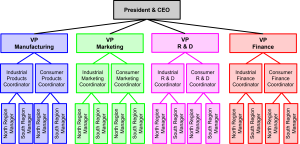
Product-Based Organizational Structure means the organization is structured by the different products the company makes. This allows managers to focus on a single product, which can lead to better product development and customer focus. However, overlap of labor often occurs as R&D for Product A is probably at least somewhat related to R&D for Product B, leading to duplication of effort.
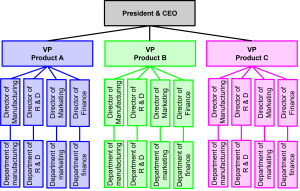
Matrix Organizational Structure combines elements of both functional and product structures. One advantage of this approach is that it encourages communication and cooperation between managers, thereby maintaining consistency across product lines and across functional departments. Given its complexity, a matrix structure can be very difficult to introduce, especially in the absence of a preexisting supportive culture. The big challenge? Employees have two bosses, so they must work together to solve the multiple goals of each product and division. Imagine getting conflicting priorities from your product manager and your functional manager – it can get complicated!
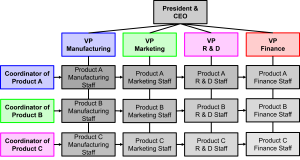
Organizational Transformation
Organizational transformation goes further than traditional OD by creating new organizational visions and changing fundamental beliefs, purposes, and missions. It addresses core organizational identity rather than simply modifying existing practices.
Two Approaches to Transformation
Organizational culture change requires a change agent with a clear vision, top management support, executives embodying the spirit of change efforts, supportive systems involvement, new hire socialization according to new culture, and conducting change with employee rights in mind.
Knowledge management represents the development, dissemination, and use of knowledge to enhance organizational capabilities and performance. Many companies have created chief knowledge officer positions to coordinate knowledge management initiatives.
Learning organizations manage knowledge effectively through structures that facilitate learning, sophisticated information systems, HR systems that promote and reward employees for continuous learning and knowledge management, strong cultures that foster openness and creativity, and supportive leaders who are active participants in learning processes.
Learning organizations have several key characteristics that make them different from traditional organizations. They have structures that actually facilitate learning rather than just talking about it. They invest in sophisticated information systems that help people access and share knowledge. Their HR systems promote and reward employees for continuous learning and knowledge management – not just for doing their current jobs well. They maintain strong cultures that foster openness and creativity, where people feel safe to experiment and even fail. Finally, they have supportive leaders who don’t just delegate learning to others but are active participants in learning processes themselves.
Think about organizations you know – do any of them really operate as learning organizations? It’s actually pretty rare, but when it works, these organizations tend to be incredibly adaptable and innovative.
Additional OD Considerations
Action Research Model deserves more attention because it represents a systematic approach to organizational change. This model combines theory building with research on real-world problems through cyclical processes where research should inform practice. The basic idea is that you can’t just implement changes based on theories – you need to study what’s actually happening in the organization, try interventions, study the results, and then adjust your approach based on what you learn. It’s like the scientific method applied to organizational change.
TQM Implementation Stages follow a specific sequence that organizations need to understand. First, you gain support of top management – without this, TQM efforts usually fail. Second, you implement statistical process control, which focuses on identifying errors and problems that are reflective of low-quality products. Third, you implement TQM processes throughout the organization. Fourth, you check and compare results, looking at “output variations” to see if quality is actually improving. Finally, you link rewards to meeting process goals of the intervention. TQM is also called continuous improvement or quality management, and the key is that it never really ends – you’re always looking for ways to improve.
Contemporary Organizational Challenges
SIOP Top 10 Trends: Key Contemporary Issues
The Society for Industrial and Organizational Psychology identifies several key trends shaping how work is organized in the modern era. These trends reflect the growing complexity of workplace environments and the need for organizations to adapt rapidly to technological, social, and economic changes.
Trend #3: Managing the Transition into Post-Pandemic Work
Remote, in-office, or hybrid – many organizations are still figuring out what will serve their workforce and customers best. As companies contemplate their options, what data should they be looking for to determine their best option? What talent-related practices and structures would need to be updated if a company switched to a new way of working? Key considerations include employee preferences and performance, customer service requirements, organizational culture maintenance, cost implications, and long-term strategic objectives.
Trend #10: Enabling Organizational Culture in a Changing Workplace Environment
While workers are working in-person, remote, hybrid, and internationally away from the office space, companies may struggle to maintain their unique organizational identity and “feeling” or sense of the organization as a whole. How will organizations communicate and maintain their culture with everyone working in different places at different times? How does a company still pass on how it feels to work there, or a sense of belonging when there are no informal “water cooler chats”?
Trend #2: Ensuring Inclusive Environments and Cultures
It’s important that organizations understand viewpoints from all employees, not just those who are in the majority. Executives need to play an active role in ensuring their programs, processes, and overall culture encourages diverse thoughts and ideas. DEI can no longer be a taskforce or team that rolls out training and events – DEI needs to be incorporated into the overall business strategy.
Additional Contemporary Challenges
Workforce evolution including generational differences, changing career expectations, and work-life integration preferences will require organizational adaptations in policies, practices, and cultures. Technology integration will continue to transform organizational structures through artificial intelligence, automation, and advanced communication technologies, requiring capabilities for human-technology collaboration while addressing workforce displacement. Sustainability considerations will increasingly influence organizational design as stakeholders demand greater attention to environmental and social responsibility.
Future Directions and Practical Applications
Emerging organizational forms will likely emphasize greater flexibility, adaptability, and responsiveness to environmental changes. Network organizations, virtual organizations, and platform-based organizations represent alternatives to traditional hierarchical structures that may better suit contemporary business environments.
You’re probably already seeing some of these emerging forms. Network organizations connect independent entities that work together toward common goals – think of how Uber connects drivers, riders, and the platform without traditional employment relationships. Virtual organizations exist primarily in digital space, with members who may never meet in person but collaborate effectively through technology. Platform-based organizations like Amazon or Apple create ecosystems where other organizations can build products and services.
Technology integration will continue to transform organizational structures and processes through artificial intelligence, automation, and advanced communication technologies. Organizations must develop capabilities for human-technology collaboration while addressing workforce displacement and skill development challenges. The question isn’t whether AI will change your job – it’s how quickly you can adapt to work alongside these new technologies.
Sustainability considerations will increasingly influence organizational design as stakeholders demand greater attention to environmental and social responsibility. Organizations that ignore sustainability issues will find themselves at a competitive disadvantage as consumers, employees, and investors increasingly care about corporate social responsibility.
Workforce evolution including generational differences, changing career expectations, and work-life integration preferences will require organizational adaptations in policies, practices, and cultures. Different generations bring different expectations to work, and successful organizations will need to accommodate these differences while maintaining coherence and effectiveness.
Practical Applications and Recommendations
Organizational diagnosis should precede change efforts through systematic assessment of current conditions, identification of improvement opportunities, and evaluation of readiness for change. You can’t fix what you don’t understand, and too many change efforts fail because organizations don’t really understand their current state before trying to change.
Change management should follow systematic approaches that include vision development, stakeholder engagement, communication planning, implementation support, and progress monitoring. Successful change doesn’t happen by accident – it requires careful planning and execution.
Leadership development must emphasize change management capabilities as organizational leaders increasingly must navigate complex, dynamic environments while supporting employee adaptation. The leaders who succeed in the future will be those who can help their organizations and people adapt to constant change.
Measurement and evaluation systems should track both short-term implementation progress and long-term organizational outcomes to ensure that change efforts produce desired results. It’s not enough to implement changes – you need to measure whether they’re actually working.
SIOP Insights on the Organization of Work
The Society for Industrial and Organizational Psychology identifies several key trends that are worth understanding because they’ll likely affect your career. These insights come from extensive research and represent what I/O psychologists are seeing as the most important developments in how work is organized.
Key Themes from SIOP Research
- Workforce Readiness and Adaptability
SIOP emphasizes that organizations must prioritize workforce readiness to thrive in a globally interconnected and rapidly evolving environment. This includes preparing employees for technological disruption, remote collaboration, and continuous learning. What does this mean for you? It means the skills that got you your first job probably won’t be enough to sustain your entire career. Organizations are looking for people who can adapt and learn continuously.
- Autonomous Learning and Employee Empowerment
Modern organizations are shifting toward learner-driven models that support autonomous learning. SIOP research highlights the importance of creating systems that allow employees to take ownership of their development, supported by flexible structures and digital tools. Instead of waiting for your employer to send you to training, successful employees increasingly take charge of their own learning and development.
- Communication in Virtual Teams
As remote and hybrid work become more common, SIOP stresses the need for intentional communication strategies. Effective virtual collaboration requires clear norms, appropriate technology, and leadership that fosters connection and trust across distributed teams. If you’ve ever been in a virtual meeting where nobody knew what they were supposed to be doing, you understand why this is so important.
- Big Data and Organizational Decision-Making
The rise of big data is transforming how organizations make decisions. SIOP encourages leaders to develop data literacy and integrate analytics into strategic planning, talent management, and organizational design. Organizations are increasingly making decisions based on data rather than just intuition or tradition.
- Inclusive and Agile Organizational Structures
SIOP’s research highlights the importance of inclusive environments and agile structures that can respond to change. Organizations must move beyond rigid hierarchies and embrace flexible, team-based models that support innovation and equity. This isn’t just about being nice – diverse, inclusive organizations actually perform better.
Practical Recommendations
By applying these evidence-based practices, organizations can create work environments that are not only efficient but also resilient, inclusive, and future-ready:
- Invest in workforce development programs that build adaptability and digital fluency
- Support autonomous learning through personalized development plans and access to resources
- Design virtual collaboration systems that promote psychological safety and engagement
- Use data analytics to inform organizational design and talent strategies
- Build inclusive cultures that reflect diverse perspectives in decision-making and leadership
Conclusion
The organization of work continues to evolve in response to technological, social, and economic changes that create new opportunities and challenges for both organizations and individuals. Understanding organizational theory and practice provides essential foundation for creating work environments that optimize human potential while achieving organizational objectives.
Think about it this way: we’ve come a long way from Taylor timing workers with stopwatches to today’s flexible, technology-enabled workplaces. The progression from classical to contemporary organizational theories reflects growing recognition of organizational complexity and the need for adaptive, flexible approaches that can respond to changing circumstances. No single organizational model provides universal solutions, which is why understanding multiple approaches and when to apply them is so valuable.
Contemporary organizational challenges including remote work, cultural diversity, technological integration, and sustainability require sophisticated understanding of organizational dynamics and change processes. Organizations must develop capabilities for continuous adaptation while maintaining the stability and coherence necessary for effective functioning. It’s like learning to ride a bike while the bike is constantly changing – you need to be adaptable but still maintain your balance.
The future of work organization will likely emphasize human-centered approaches that recognize employees as whole persons with diverse needs and capabilities rather than simply economic resources. This evolution requires integration of technical and social considerations in organizational design while maintaining focus on both performance and well-being outcomes.
For you as someone entering or advancing in your career, understanding these organizational concepts will help you navigate different workplace environments, contribute more effectively to organizational success, and perhaps even influence positive changes in the organizations where you work. The most successful professionals are those who understand not just their own jobs, but how their organizations work and how to help them work better.
You might be thinking, “This is all interesting, but how does it actually help me?” Here’s the thing: when you understand organizational theory, you can better assess potential employers, navigate workplace politics, contribute to change initiatives, and position yourself as someone who gets the big picture. These skills become increasingly valuable as you advance in your career.
Success in organizing work ultimately depends on alignment between organizational structures, processes, cultures, and strategies with environmental demands and human capabilities. This alignment requires ongoing attention to multiple stakeholder interests while maintaining focus on long-term sustainability and adaptation capabilities.
The organizations that thrive in the future will be those that can balance efficiency with humanity, structure with flexibility, and tradition with innovation. As future managers and employees, you’ll play a crucial role in shaping how work gets organized. The concepts you’ve learned in this module provide the foundation for making those decisions wisely.
Media Attributions
- Organizational Chart of the Tabulating Machine Company © Tabulating Machine Company is licensed under a CC BY (Attribution) license
- Kurt Lewin’s Force Field Analysis Model of Organizational Change adapted by Jay Brown
- Kurt Lewin’s Three-Stage Model of Organizational Change adapted by Jay Brown
- Action Research Model adapted by Jay Brown
- Functional Organizational Structure adapted by Jay Brown
- Product-Based Organizational Structure adapted by Jay Brown
- Matrix Organizational Structure adapted by Jay Brown
